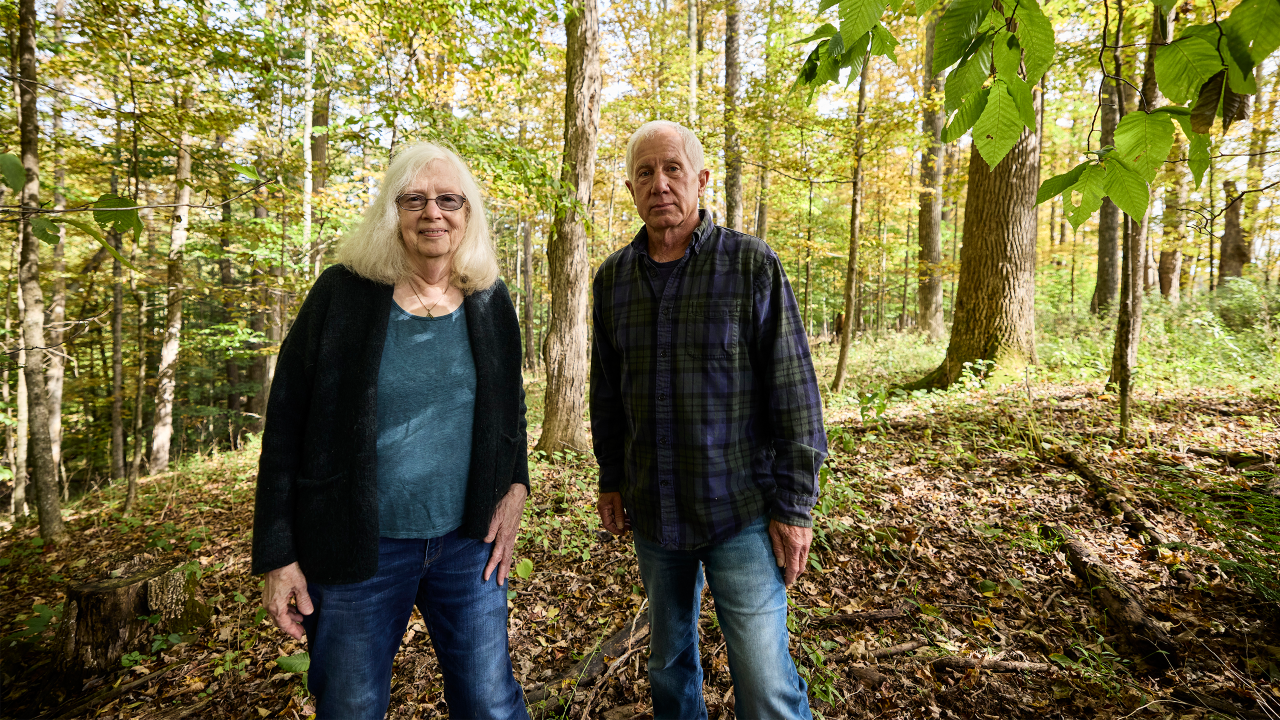
Stewards of The Forest: Bust and boom
Image: Nancy Baker and forester Daniel Swift on Nancy’s plot of land. Photography by Petr Krejci.
Stewards of The Forest: Stories of the people behind the diverse naturally regenerated hardwood forests of the eastern United States
Bust and boom
Way up in the Endless Mountains of Northern Pennsylvania, in remote Bradford County, sit 160 acres of forest that have been in Nancy Baker’s family for 162 years. Nancy is the fourth generation to tend this land, and after repeated efforts to harvest the forest and farm the wasteland left behind, she is taking it back to sylvan nature. The plot has gone full circle, rather like the rest of the state, where natural forests plundered to destruction are now restored. It is a tale of environmental redemption.
Nancy’s patch of woodland sits where two creeks meet, not far from the Susquehanna River. Her great grandfather, Joseph Morrow Gamble, a descendant of Scots-Irish immigrants, bought it back in 1861. “He cleared most of the land with a yoke of oxen,” feeding the logs into a small water-powered sawmill, she says.
With the trees gone, Nancy’s grandfather, fiddle-playing Joseph Sidney Gamble, turned to farming. He grew rapeseed that he fed to hogs, and hay sent by train to livery stables in New York City. When her father, teacher Paul Walker, took over in the 1940s, he gave up farming and planted 60,000 red pine trees for future income.
As a child, Nancy roamed the woods and dedicated her life to forests. But she had an ecological bent. When she inherited the land in the 1980s, she allowed the pine trees to age, fall and recycle their nutrients on the forest floor, while helping nature restore a more native, natural and diverse woodland. It is still work in progress, she says. “But for me the most important purpose is to have the forest.”
The story of Nancy’s family and how four generations have managed one small plot in the back woods of Pennsylvania is in microcosm a glimpse of a vast transformation of the state in the past two centuries. From boom to bust and from bust to revival. From eco-cide to eco-science and sustainable management.
It has been a hell of a journey. But it shows, perhaps like nowhere else, how even the most plundered forests can be restored through natural regeneration.
--
Back in the 17th century, white pine, hemlock, maple and beech covered 90% of the state, whose name means Penn’s Woods. But axes were soon at work. Early colonists cut white pine for the masts of British sailing ships, and the destruction accelerated dramatically with the arrival of steam-powered sawmills. The state grew rich supplying lumber for firewood and fence posts, pit props and construction materials, railroad ties and furniture, charcoal to fuel iron-ore furnaces and bark for tannin used in leather-making.
At the late-19th century peak, the biggest lumber center was Williamsport on the Susquehanna River. Lumberjacks floated millions of logs cut from the surrounding hills down the river to the “lumber capital of the world”, where they were chained between huge piers to supply some 60 sawmills. This holding area, known as the “boom”, extended for seven miles along the river, and could hold 300 million board-feet. The world had seen nothing like it.
For miles around, the lumber barons owned everything: the forests, the sawmills, the boom, the woodworking factories, the railroads, the banks and real estate companies. Men such as Peter Herdic, the “king of lumbermen”, accumulated huge fortunes. Williamsport had more millionaires per capita than any other city in the U.S. Most lived in big mansions on East Fourth Street, still known locally as Millionaire’s Row. You can take a guided tour of the street, or dine at Herdic’s House.
But boom turned to bust. In May 1889, a huge flood rushed down the Susquehanna River. The river that had brought Williamsport its wealth brought its destruction, carrying away bankside sawmills, breaking the boom, and rushing its logs south into Chesapeake Bay.
Because the surrounding forests were largely logged out, most of the sawmills were never rebuilt. The millionaires took their money and went west to where there were still forests. They left behind a landscape of what an official report in 1895 called “stumps and ashes” on rapidly eroding hillsides.
The state authorities soon stepped in to buy up the wastelands, in the hope of creating new state and national forests. The largest, the Allegheny National Forest, covered more than half a million acres of an area once known as the “Allegheny brush heap”.
Replanting went into overdrive during the 1930s, when the New Deal’s Civilian Conservation Corps planted around 50 million new trees, often red pines. But most of the regrowth has been through natural restoration, much of it on private land.
It has been spectacularly successful, with hundred-year-old hardwoods prospering, especially in the mountains of the west of the state. The species mix has changed somewhat. There are many more oak trees now, and lots of maple. Cherry too had a bonanza in the sunlit open spaces created by deforestation.
Today, 60% of Pennsylvania is once again forest. It is the largest producer of hardwood lumber in the country, yet logging is only at half the rate of regrowth. The Allegheny National Forest, which celebrated its centenary in 2023, is a paragon of science-based sustainable management, with logging companies operating under strict supervision by federal forest ecologists. For most of the late 20th century, it was known as the black cherry capital of the world.
To the east, Potter County on the Susquehanna was once desecrated to provide the logs for sawmills all the way to Williamsport. Today, it too is forested once more. In Cherry Spring State Park - a remote enclave also cherished by stargazers for its dark skies - they are now harvesting mature cherry trees that have been growing since the restoration began a century ago.
But echoes of the hell-for-leather days remain.
Chuck Luppert, a scion of the Luppert dynasty of 19th century loggers, was born and raised in Williamsport. He became the President of the town’s main bank, looking after what is left of its lumber-generated wealth. In retirement, he volunteers at the town museum, keeping alive its lumber history.
And there is Nancy Baker, one of an estimated 700,000-plus smallholders with a patch of forest. “Each is doing their own thing,” she says. But an ever-greater number now care more about maintaining their trees than making money from them – particularly women, who make up a fifth of America’s forest owners.
Nancy has brought her forestry skills, honed over half a century, to help them. She is chair of the Pennsylvania Forest Stewards and leads Women and Their Woods, a volunteer organisation that trains women to both handle a chainsaw and become ecological custodians of their forests.
And at night, back in her ancestral woodland, she sleeps in a rope bed with a carved maple frame that her great, great grandmother brought by ox-cart from Vermont to Bradford County. “It’s been storing carbon for 200 years,” she says. “That’s a nice thought to wake up with.”
